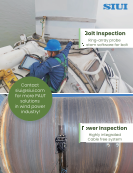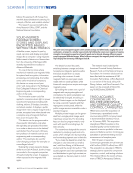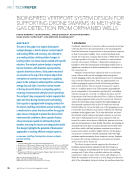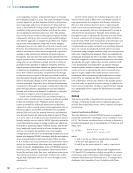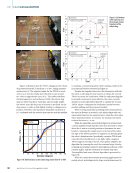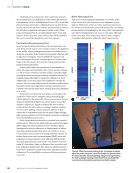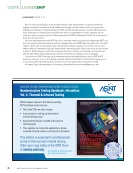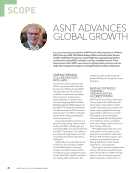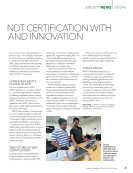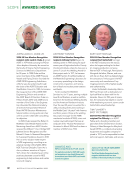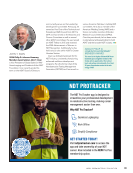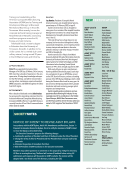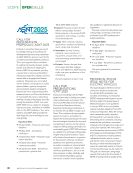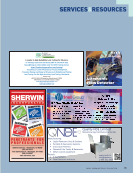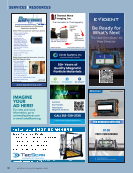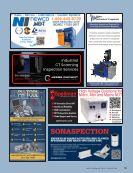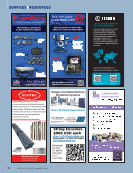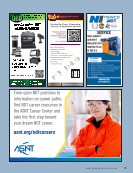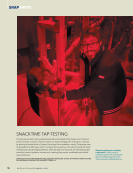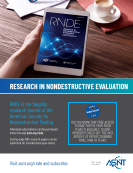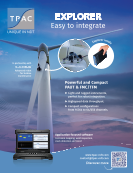EDGE COMPUTING MAKES NDE SMARTER
Traditional nondestructive evaluation
(NDE) has no use for edge computing,
but that is about to change.
The use of artificial intelligence (AI) and
machine learning (ML) requires significant
computational power. As AI/ML adoption
grows, the computational demands on
inspection equipment increase rapidly.
This is especially true for ultrasonics, but
the same trend is seen in other NDE
methods as well.
While cloud computing offers power,
it’s cumbersome for handling large,
sensitive datasets. Standard laptops
and off-the-shelf NDE equipment lack
the necessary computational resources.
The emerging solution is to add a sepa-
rate computing unit to the system: an
edge computer. This has surprising
implications.
Background
Traditional inspections are done by
keying in the settings on the screen
of the NDT machine. The equipment
may employ sophisticated electronics
(like field-programmable gated arrays,
FPGAs), but they must remain versa-
tile—configurable and adjustable for any
potential task the inspectors might face.
As inspections grow more complex, it’s
becoming increasingly problematic to
configure or program these machines.
This leads to overly complex procedures,
where human inspectors need to
manage the minute details of the inspec-
tion settings and oversee the process.
Then there are highly automated
inspection cells, which complete
predefined inspection routines with
the help of complicated mechanics or
robotics, acquiring data in a fully auto-
mated way. However, even in these
cases, the underlying NDE electronics
are often built on a general-purpose
NDE device, with the smart features
focused more on the mechanics than the
NDE itself.
Inspections are getting more
complex, with more channels, more
elements, and more data. While more
data improves inspections, it also places
a significant burden on the evalua-
tion process. Increasingly, advanced
signal processing techniques like total
focusing method (TFM) beamforming
are used, further raising computational
requirements.
All of this leads to overcomplicated
inspection software and procedures for
inspectors. The complexity then trans-
lates to reduced focus on inspection
targets and increased risk of human error.
Progress Up Until Now
The way to deploy AI locally and easily
on top of existing inspections turns out
to be edge computing. These small
boxes contain impressive computa-
tional power and can be connected
to the inspector’s PC or local network,
processing the huge data files produced
by modern techniques in seconds.
Additionally, software installations,
updates, and version control can be
handled directly on the box, avoiding
the typical hassle of installing additional
software on corporate computers. (This
was the immediate issue that brought
edge computers to the industry.) But
there’s more.
As soon as the computational power
is available, it can also be used to
improve signal processing. This enables
the use of many techniques that have
been known for a long time but were
too complex to be used in practice,
such as the synthetic aperture focusing
technique (SAFT) in ultrasonic testing.
Sophisticated signal processing can
be provided in software tailored to the
needs of the procedure.
Edge computers can also be directly
connected to traditional NDE equip-
ment, such as ultrasonic or eddy current
machines, or cameras for visual inspec-
tion. This allows the edge computer to
take over tasks traditionally assigned to
the machine’s electronics, enabling the
freedom to use even the most sophis-
ticated signal processing, filtering, and
reconstruction algorithms.
Taken together, this enables us to
build systems that process and automat-
ically evaluate data as it’s acquired and
generate reports on findings as soon as
the acquisition is complete. It allows us
to upgrade traditional rule-based auto-
mated inspection systems used in manu-
facturing to more robust smart systems
that reduce false calls, improve sensitivity,
and, most importantly, enable better
discrimination between benign indica-
tions and unacceptable defects.
SCANNER
|
NDEOUTLOOK
Edge computing devices are commonly used to implement local AI/ML evaluation on top of
existing inspections.
14
M AT E R I A L S E V A L U AT I O N • A P R I L 2 0 2 5
CREDIT:
TRUEFLAW
LTD.
Traditional nondestructive evaluation
(NDE) has no use for edge computing,
but that is about to change.
The use of artificial intelligence (AI) and
machine learning (ML) requires significant
computational power. As AI/ML adoption
grows, the computational demands on
inspection equipment increase rapidly.
This is especially true for ultrasonics, but
the same trend is seen in other NDE
methods as well.
While cloud computing offers power,
it’s cumbersome for handling large,
sensitive datasets. Standard laptops
and off-the-shelf NDE equipment lack
the necessary computational resources.
The emerging solution is to add a sepa-
rate computing unit to the system: an
edge computer. This has surprising
implications.
Background
Traditional inspections are done by
keying in the settings on the screen
of the NDT machine. The equipment
may employ sophisticated electronics
(like field-programmable gated arrays,
FPGAs), but they must remain versa-
tile—configurable and adjustable for any
potential task the inspectors might face.
As inspections grow more complex, it’s
becoming increasingly problematic to
configure or program these machines.
This leads to overly complex procedures,
where human inspectors need to
manage the minute details of the inspec-
tion settings and oversee the process.
Then there are highly automated
inspection cells, which complete
predefined inspection routines with
the help of complicated mechanics or
robotics, acquiring data in a fully auto-
mated way. However, even in these
cases, the underlying NDE electronics
are often built on a general-purpose
NDE device, with the smart features
focused more on the mechanics than the
NDE itself.
Inspections are getting more
complex, with more channels, more
elements, and more data. While more
data improves inspections, it also places
a significant burden on the evalua-
tion process. Increasingly, advanced
signal processing techniques like total
focusing method (TFM) beamforming
are used, further raising computational
requirements.
All of this leads to overcomplicated
inspection software and procedures for
inspectors. The complexity then trans-
lates to reduced focus on inspection
targets and increased risk of human error.
Progress Up Until Now
The way to deploy AI locally and easily
on top of existing inspections turns out
to be edge computing. These small
boxes contain impressive computa-
tional power and can be connected
to the inspector’s PC or local network,
processing the huge data files produced
by modern techniques in seconds.
Additionally, software installations,
updates, and version control can be
handled directly on the box, avoiding
the typical hassle of installing additional
software on corporate computers. (This
was the immediate issue that brought
edge computers to the industry.) But
there’s more.
As soon as the computational power
is available, it can also be used to
improve signal processing. This enables
the use of many techniques that have
been known for a long time but were
too complex to be used in practice,
such as the synthetic aperture focusing
technique (SAFT) in ultrasonic testing.
Sophisticated signal processing can
be provided in software tailored to the
needs of the procedure.
Edge computers can also be directly
connected to traditional NDE equip-
ment, such as ultrasonic or eddy current
machines, or cameras for visual inspec-
tion. This allows the edge computer to
take over tasks traditionally assigned to
the machine’s electronics, enabling the
freedom to use even the most sophis-
ticated signal processing, filtering, and
reconstruction algorithms.
Taken together, this enables us to
build systems that process and automat-
ically evaluate data as it’s acquired and
generate reports on findings as soon as
the acquisition is complete. It allows us
to upgrade traditional rule-based auto-
mated inspection systems used in manu-
facturing to more robust smart systems
that reduce false calls, improve sensitivity,
and, most importantly, enable better
discrimination between benign indica-
tions and unacceptable defects.
SCANNER
|
NDEOUTLOOK
Edge computing devices are commonly used to implement local AI/ML evaluation on top of
existing inspections.
14
M AT E R I A L S E V A L U AT I O N • A P R I L 2 0 2 5
CREDIT:
TRUEFLAW
LTD.





